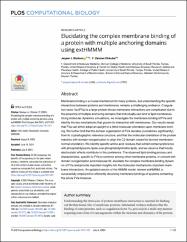Elucidating the complex membrane binding of a protein with multiple anchoring domains using extHMMM
Abstract
Membrane binding is a crucial mechanism for many proteins, but understanding the specific
interactions between proteins and membranes remains a challenging endeavor. Coagulation factor Va (FVa) is a large protein whose membrane interactions are complicated due to
the presence of multiple anchoring domains that individually can bind to lipid membranes.
Using molecular dynamics simulations, we investigate the membrane binding of FVa and
identify the key mechanisms that govern its interaction with membranes. Our results reveal
that FVa can either adopt an upright or a tilted molecular orientation upon membrane binding. We further find that the domain organization of FVa deviates (sometimes significantly)
from its crystallographic reference structure, and that the molecular orientation of the protein
matches with domain reorganization to align the C2 domain toward its favored membranenormal orientation. We identify specific amino acid residues that exhibit contact preference
with phosphatidylserine lipids over phosphatidylcholine lipids, and we observe that mostly
electrostatic effects contribute to this preference. The observed lipid-binding process and
characteristics, specific to FVa or common among other membrane proteins, in concert with
domain reorganization and molecular tilt, elucidate the complex membrane binding dynamics of FVa and provide important insights into the molecular mechanisms of protein-membrane interactions. An updated version of the HMMM model, termed extHMMM, is
successfully employed for efficiently observing membrane bindings of systems containing
the whole FVa molecule.


















